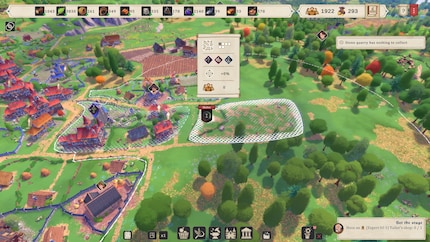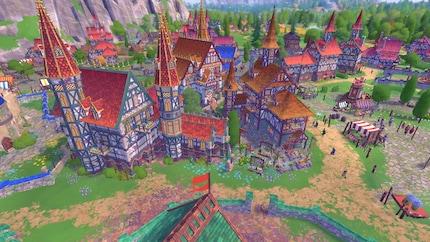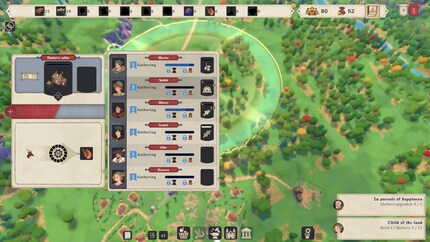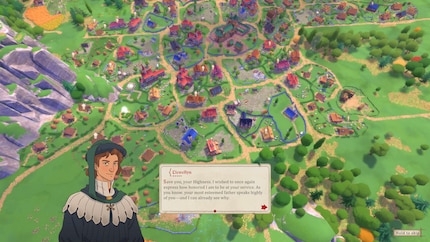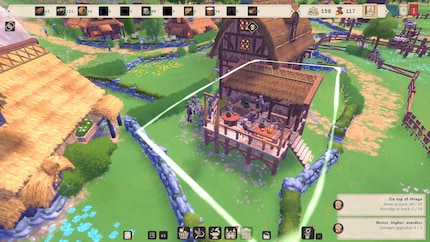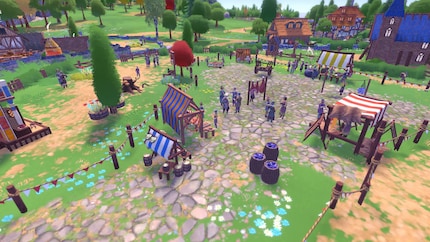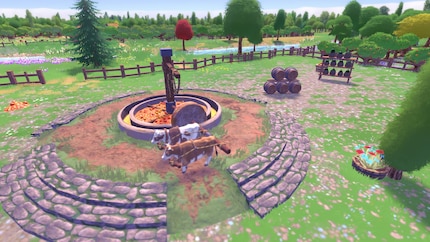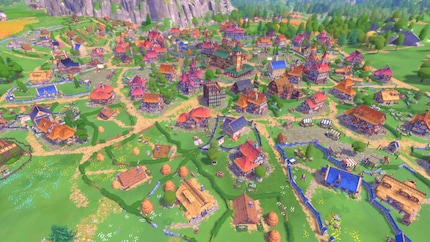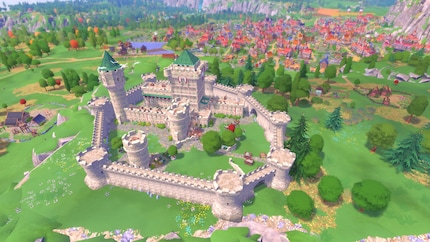
Background information
Through the park with the insect battle tank: I played "Grounded 2"
by Debora Pape

The new medieval city planning simulator City Tales: Medieval Era promises creative gameplay without a grid. I tried it out and found a lot of similarities to Anno 1800.
I’m doing pretty well. My father – the king – gives me a productive, idyllic stretch of land so that I can build a prosperous settlement that’ll benefit the kingdom. Fortunately, I have an able advisor – who looks suspiciously like Sean Connery in The Name of the Rose. I’ve also got a few companions with me to lend a hand. It doesn’t take long for the first artisans and merchants to settle in my growing city.
I soon see progress in the pretty indie building simulator City Tales: Medieval Era. But too soon for my taste. After just six hours, I already have a large castle, several theatres and impressive villas in my little town.
Unlike in most urban planning simulators, I don’t install buildings myself or define the zones where they’re to be built. In City Tales, everything works via districts, which accommodate residential and commercial buildings. I define the outer boundary of one of the districts using a special tool. The area doesn’t need to be a specific shape.
Each district influences other districts in the vicinity. For example, if there’s a fountain and theatre in a district, those neighbouring also get the use of water and entertainment. A lot of buildings also need others nearby in order to construct them, which can sometimes seem arbitrary. Why does the tannery need a market and a church close to it?
Nevertheless, I like the idea of the asymmetrical and differently sized districts. This creates cities that look much more organic than in Anno 1800, for instance, with its 90-degree angle grid.
Speaking of Anno 1800, City Tales has used it as a template for its residential building upgrades. By that I mean I manually upgrade buildings when the occupants’ needs are met. This always includes access to certain commercial buildings nearby. For example, a fountain, market or church. I also need to have enough resources, such as stones and wood – and later also roof tiles and cement – in the warehouse.
Unlike the famous prototype, not every house has the same upgrade requirements. While the residents of one home might prefer to have a church nearby, their neighbours may want to go to the theatre. When it comes down to it, it doesn’t really matter, as I make sure there’s an equal spread of all the types of buildings. I like this approach, but maybe it could be expanded.
The companion concept in City Tales is also new to me. Rather than being a controllable hero figure, my companions are artisans. Each new production building needs to first be occupied by one of my companions. This is how the game explains it: the companion sets up the business and trains my villagers. After a while, the inhabitants get to know the trade and I can use my companion elsewhere.
During their assignments, my companions collect experience points – as a blacksmith, for example, in the «production» sphere. They can then use their experience in other «production» buildings. The more experience they gain in this area, the more efficiently and quickly the buildings they assist in actually work.
Generally speaking, I like this concept, but it doesn’t offer much depth in terms of gameplay. Obviously, I try to appoint companions where they can make good use of their newly acquired skills – but that doesn’t require a lot of brainpower or planning.
Companions also give me tasks from time to time. The instructions are nicely written, but the tasks themselves aren’t very complex, such as upgrading five houses or producing 30 ciders. I do these tasks as a matter of course anyway. Completing some unlocks new production and commercial buildings. In this game, there’s no tech tree.
I keep the increasingly demanding villagers happy with new buildings. Mind you, «happy» isn’t quite accurate, as there’s no happiness value in City Tales. I don’t get a sense of my subjects’ daily hardships.
This is also due to the fact that there’s hardly anything to manage. Manufactured products are purely virtual. Nothing’s transported and I don’t have to store anything. The products only seem to exist in the upper interface bar, which provides information about the quantity globally available along with production trends (stock increasing, decreasing or steady). The display is very clear and easy to understand, even for newcomers to the genre.
With little administration and optimisation required, the game is simple, not to mention undemanding. If anywhere is missing a product or service, I simply construct the right building where the requirements are met. The rest of the time, I save up for new buildings or residential upgrades. Aside from creating new districts, this is actually the entire content of the game.
I often end up short of money. Another problem is that I’ve got no insight into my balance sheets. They’d be straightforward enough given that there’s no building maintenance or salaries to deal with. The only costs come from construction or upgrades.
On the revenue side, there’s the income I get from my residents. The higher the level of a residential building, the more taxes the residents have to pay – but when and how often? Sometimes I wait for a few gold coins before I build a house, but my wallet doesn’t see any of those for ages. There’s no schedule for when I receive income, for instance at the end of the month.
Even decorative objects such as extra trees, washing lines and signs, which are incredibly reminiscent of Foundation, don’t seem to serve any purpose. Usually, I like to decorate my cities. But there’s no incentive to do that in City Tales. The houses and gardens, which the game creates itself, are already brightly coloured and beautifully decorated. Adding the odd few decorative flower pots along the streets is hardly something you notice.
After gaming for barely six hours, there are already almost 2,000 inhabitants in my town. The streets and districts are full of people, but I don’t have any connection with them. It’s not like I need to assign workers, as everything happens automatically. This is also reminiscent of Anno 1800. The tradespeople in front of the buildings work hard without any interruptions. Once the carpenter is at his saw, he carries on working.
My subjects are a mere backdrop. Although City Tales is really pretty, I hardly have any reason to look at houses and people up close. Unlike in other games, I don’t wait with bated breath to see when the porter will finally bring the long-awaited bread to the warehouse. Neither do I have to wait for construction workers at building sites. Everything happens quickly and automatically, which is a shame.
In order to build the castle, I have to save up for a while. I was looking forward to finishing it and possibly getting to know a new gameplay mechanic. But there’s nothing. Although my advisor praises me after the opening ceremony, he doesn’t hand over any money, new building plans or anything else. And worst of all, the castle doesn’t even seem to serve a purpose at the moment. This makes it a purely (expensive) decorative object.
I can tell that love and dedication has gone into City Tales. The characters are beautifully drawn, the dialogue has been affectionately crafted and the surroundings are packed full of wonderful details.
But none of that helps if the game doesn’t captivate me. When I can build a large city so quickly, the successes pale in comparison. I can’t get excited about having unlocked new buildings because it wasn’t difficult. There’s not enough to organise and plan. The game has some fresh ideas, but there’s room for improvement in terms of medium-term motivation. That’s OK as the game is in early access.
Perhaps I’ve become a bit too discerning given the huge number of urban planning simulators available. City Tales: Medieval Era isn’t a bad game and offers a few exciting approaches. If you like relaxed gameplay without a lot of management and you don’t want to worry about financial bankruptcy, war, disease and unhappy inhabitants, you might like it.
City Tales: Medieval Era is available in early access on Steam for Windows from 22 May. Firesquid kindly provided me with a copy of the game for testing purposes.
Feels just as comfortable in front of a gaming PC as she does in a hammock in the garden. Likes the Roman Empire, container ships and science fiction books. Focuses mostly on unearthing news stories about IT and smart products.
Interesting facts about products, behind-the-scenes looks at manufacturers and deep-dives on interesting people.
Show all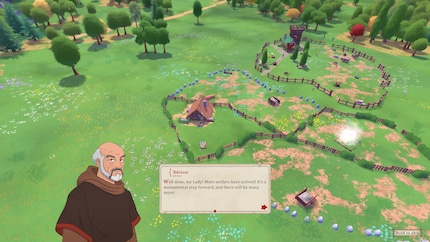
City Tales is impressive on both a visual and sound level. Higher-level buildings in particular are designed in great detail. Think winding city villas with bay windows, dormers and turrets set in gardens with colourful flowers. The surroundings are also full of pretty details: flower meadows, glistening streams and naturally formed paths in between are reminiscent of the city-building gem Foundation. The soundtrack also gurgles unobtrusively in the background, ensuring a relaxed atmosphere in City Tales. But what about the gameplay?
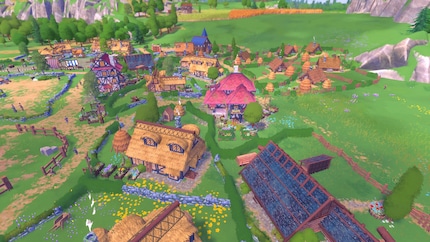

A district has plots for several buildings. If my town needs new houses, the villagers build them themselves in districts with free plots of land. Similarly, I can only commission commercial and trade buildings in districts. My royal subjects decide which plot of land will be used for this. When there are no free plots, my eager villagers tear down a house without batting an eyelid and throw the inhabitants out of the neighbourhood. Alright. Well, as long as nobody complains to me, I’m happy. And you don’t get complaints in City Tales.
